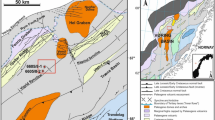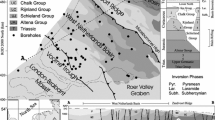Abstract
Doleritic sill complexes, which are an important component of volcanic continental margins, can be imaged using 3D seismic reflection data. This allows unprecedented access to the complete 3D geometry of the bodies and an opportunity to test classic sill emplacement models. The doleritic sills associated with basaltic volcanism in the North Rockall Trough occur in two forms. Radially symmetrical sill complexes consist of a saucer-like inner sill at the base with an arcuate inclined sheet connecting it to a gently inclined, commonly ragged, outer rim. Bilaterally symmetrical sill complexes are sourced by magma diverted from a magma conduit feeding an overlying volcano. With an elongate, concave upwards, trough-like geometry bilaterally symmetrical sills climb away from the magma source from which they originate. Both sill complex types can appear as isolated bodies but commonly occur in close proximity and consequently merge, producing hybrid sill complexes. Radial sill complexes consist of a series of radiating primary flow units. With dimensions up to 3 km, each primary flow unit rises from the inner saucer and is fed by primary magma tube. Primary flow units contain secondary flow units with dimensions up to 2 km, each being fed by a secondary magma tube branching from the primary magma tube. Secondary flow units in turn are composed of 100-m scale tertiary flow units. A similar branching hierarchy of flow units can also be seen in bilaterally symmetrical sill complexes, with their internal architecture resembling an enlarged version of a primary flow unit from a radial sill complex. This branching flow pattern, as well as the interaction between flow units of varying orders, provides new insights into the origin of the structures commonly seen within sill complexes and the hybrid sill bodies produced by their merger. The data demonstrate that each radially symmetrical sill complex is independently fed from a source located beneath the centre of the inner saucer, grows by climbing from the centre outwards and that peripheral dyking from the upper surface is a common feature. These features suggest a laccolith emplacement style involving peripheral fracturing and dyking during inner saucer growth and thickening. The branching hierarchy of flow units within bilaterally symmetrical sill complexes is broadly similar to that of primary flow units within a radially symmetrical sill complex, suggesting that the general features of the laccolith emplacement model also apply.












Similar content being viewed by others
References
Baer G (1995) Fracture propagation and magma flow in segmented dykes: field evidence and fabric analyses, Makhtesh Ramon, Israel. In: Baer G, Heimann A (eds) Physics and chemistry of dykes. Balkema, Rotterdam, pp 125–140
Bradley J (1965) Intrusion of major dolerite sills. Trans R Soc NZ 3:27–55
Burger CAJ, Hodgson FDI, Van der Linde PJ (1981). Hidroliese eienskappe van akwifere in die Suid-Vrystaat. Die ontwikkeling en evaluering van tegnieke vir die bepaling van die ontginninspotensiaal van grondwaterbronne in die Suid-Vrystraat en in Noord-Kaapland. Inst. Groundwater Stud., Univ. Orange Free State, Bloemfontein, South Africa. 2:115
Chevalier L, Woodford A (1999) Morph-tectonics and mechanism of emplacement of the dolerite rings and sills of the western Karoo, South Africa. S Afr J Geol 102:43–54
Davies R, Bell BR, Cartwright JA, Shoulders S (2002) Three-dimensional seismic imaging of Paleogene dike-fed submarine volcanoes from the northeast Atlantic margin. Geology 30:223–226
Du Toit AL (1920) The Karoo dolerite of South Africa: a study of hypabyssal injection. Trans Geol Soc S Afr 23:1–42
Francis EH (1982) Magma and sediment-I. Emplacement mechanism of late Carboniferous tholeiite sills in northern Britain. J Geol Soc Lond 139:1–20
Francis EH, Walker BH (1986) Emplacement of alkali-dolerite sills relative to extrusive volcanism and sedimentary basins in the Carboniferous of Fife, Scotland. Trans R Soc Edinb 77:309–323
Grapes RH, Reid DL, McPherson JG (1972) Shallow dolerite intrusion and phreatic eruption in the Allan Hills region, Antarctica. NZ J Geol Geophys 17:563–577
Hitchen K, Ritchie JD (1993) New K-Ar ages, and a provisional chronology, for the offshore part of the British Tertiary Igneous Province. Scott J Geol 29:73–85
Johnson GAL, Dunham KC (2001) Emplacement of the Great Whin Dolerite Complex and the Little Whin Sill in relation to the structure of Northern England. Proc Yorkshire Geol Soc 53:177–186
Jones EJW, Ramsay ATS, Preston NJ, Smith ACS (1974) A cretaceous guyot in the Rockall Trough. Nature 251:129–131
Kidd GD (1999) Fundamentals of 3D seismic volume visualization. Leading Edge 18:702–709
Leaman DE (1975) Form, mechanism, and control of dolerite intrusion near Hobart, Tasmania. J Geol Soc Aust 22:175–186
Morton AC, Hitchen K, Ritchie JD, Hine NM, Whitehouse M, Carter SG (1995) Late cretaceous basalts from Rosemary Bank, northern Rockall Trough. J Geol Soc Lond 152:947–952
Mussett AE, Dagley P, Skelhorn RR (1988) Time and duration of activity in the British Tertiary Volcanic Province. In: Morton AC, Parson LM (eds) Early Tertiary volcanism and opening of the NE Atlantic. Geol Soc Lond Spec Pub 39:337–348
Pollard DD, Johnson AM (1973) Mechanics of growth of some laccolith intrusions in the Henry Mountains, Utah, Part II. Tectonophysics 18:311–354
Pollard DD, Muller OH, Dockstader DR (1975) The form and growth of fingered sheet intrusions. Geol Soc Am Bull 86:351–363
Rickwood PC (1990) The anatomy of a dyke and the determination of propagation and magma flow. In: Parker AJ, Rickwood PC, Tucker DH (eds) Mafic dykes and emplacement mechanisms. Balkema, Rotterdam, pp 81–100
Roberts JR (1970) The intrusion of magma into brittle rocks. In: Newall G, Rast N (eds) Mechanism of igneous intrusion. Geol J Spec Issue 2, p 380
Smallwood JR, Maresh J (2002) The properties, morphology and distribution of igneous sills: modelling, borehole data and 3D seismic data from the Faeroe-Shetland area. In: Jolley DW, Bell BR (eds) The North Atlantic Igneous Province: Stratigraphy, tectonic, volcanic and magmatic processes. Geol Soc Lond Spec Pub 197:271–306
Smythe DK (1989) Rockall Trough—Cretaceous or Late Palaeozoic? Scott J Geol 25:5–43
Spry AH (1958) Some observations of the Jurassic dolerite of the Eureka cone sheet near Zeehan, Tasmania. In: Dolerite: a symposium. Hobart University, Tasmania, pp 93–129
Stoker MS, Hitchen K, Graham CC (1993) The geology of the Hebridies and west Shetland Shelves, and adjacent deep water areas. United Kingdom Offshore Regional Report, Br Geol Surv Lond, 149 pp
Tate MP, Dodd CD, Grant NT (1999) The Northeast Rockall Basin and its significance in the evolution of the Rockall-Faeroes/East Greenland rift system. In: Fleet AJ, Boldy SAR (eds) Petroleum geology of Northwest Europe: Proceedings of the 5th Conference. Geol Soc Lond, pp 391–406
Upton BGJ (1988) History of Tertiary igneous activity in the North Atlantic borderlands. In: Morton AC, Parsons LM (eds) Early Tertiary volcanism and the opening of the NE Atlantic. Geol Soc Lond Spec Publ 39:429–454
White RS (1988) A hot-spot model for early Tertiary volcanism in the N Atlantic. In: Morton AC, Parsons LM (eds) Early Tertiary volcanism and the opening of the NE Atlantic. Geol Soc Lond Special Publ 39:3–13
White RS, McKenzie D (1989) Magmatism at rift zones: the generation of volcanic continental margins and flood basalts. J Geophys Res 94:7685–7729
Wood MV, Hall J, Doody JJ (1988) Distribution of early Tertiary lavas in the NE Rockall Trough. In: Morton AC, Parsons LM (eds) Early Tertiary volcanism and the opening of the NE Atlantic. Geol Soc Lond Spec Publ 39:283–292
Yilmaz Ö (2001) Seismic data analysis processing, inversion and interpretation of seismic data. Soc Explor Geophys Tulsa, 2,027 pp
Acknowledgements
Thanks to Amerada Hess Ltd. for their financial support of this project and to PGS Exploration (UK) Ltd. (Jerry Witney and Huw Edwards) for the release of seismic data and permission to publish the results. Thanks also to our colleagues in Birmingham (Bill Owens, Jonathan Turner, Graham Westbrook, Dirk Liss and Gareth Williams) for their help and advice during this project.
Author information
Authors and Affiliations
Corresponding author
Additional information
Editorial responsibility: J. Stix
Rights and permissions
About this article
Cite this article
Thomson, K., Hutton, D. Geometry and growth of sill complexes: insights using 3D seismic from the North Rockall Trough. Bull Volcanol 66, 364–375 (2004). https://doi.org/10.1007/s00445-003-0320-z
Received:
Accepted:
Published:
Issue Date:
DOI: https://doi.org/10.1007/s00445-003-0320-z




